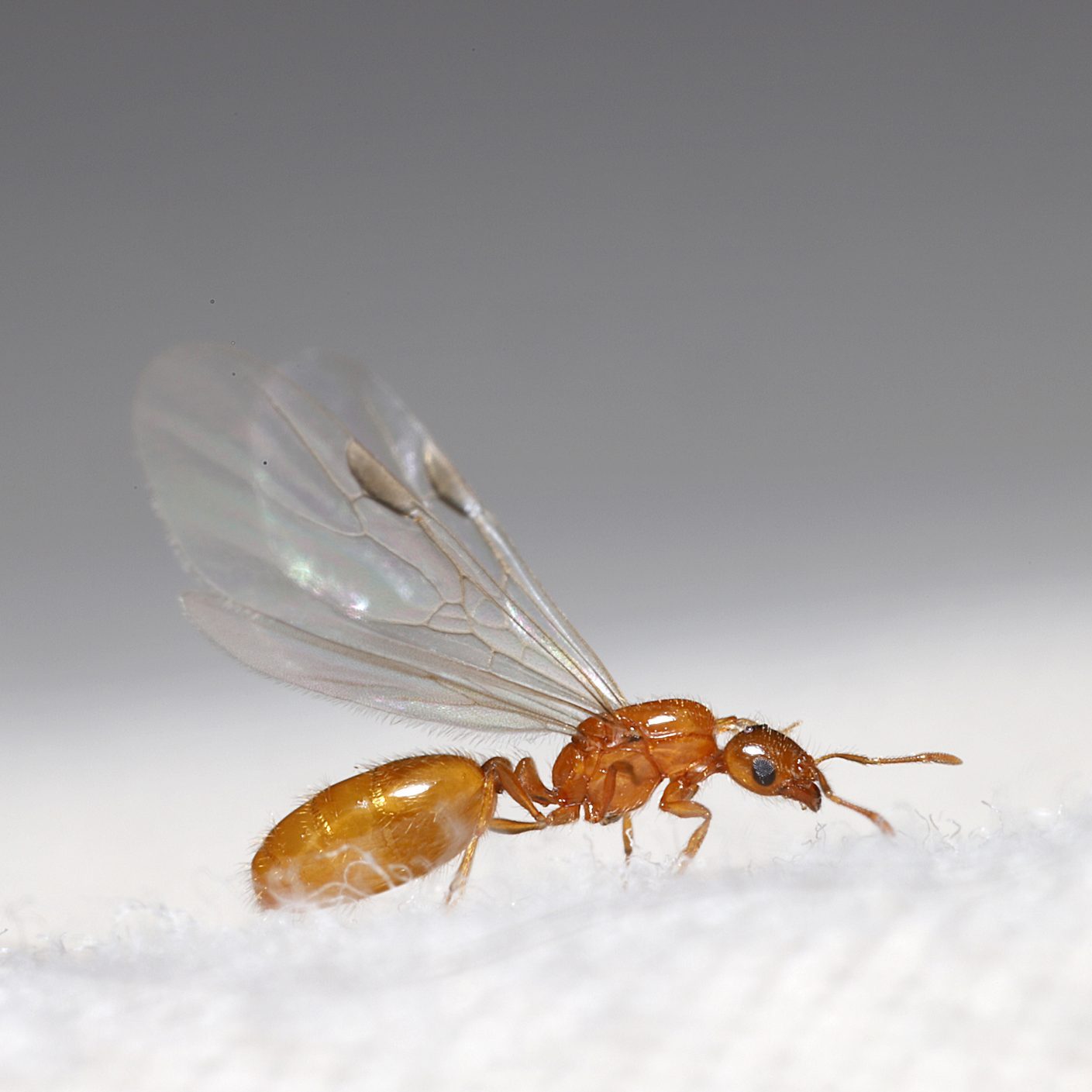Encountering a swarm of airborne arthropods in and around your home can be unsettling. Don't panic! Here's what you need to know about flying ants.

Homeowner’s Guide To Flying Ants

Taking to the skies for what is often referred to as their “nuptial flight,” a flying ant (AKA winged or swarming ant) is a reproducing member of the species, or what entomologists call an “alate.”
On This Page
What Is a Flying Ant?
A flying ant is essentially a regular ant that’s sprouted wings.
At certain times each year, most of the 1,000 known species of ants found in the U.S. grow wings and set off into the air to engage in breeding behaviors. It may sound like a good time — unless you’re a male — in which case after you’ve fully performed your duty, the impregnated female eats you for lunch. Fluttering off post-coital in search of a suitable nesting site, the new queen chews off her own wings and begins the important work of populating a new colony. Ah, romance!
What Do Flying Ants Look Like?
Often confused with the dreaded wood-devouring termite, to the untrained eye winged ants (especially winged carpenter ants) and termites look a lot alike.
There isn’t just one kind of flying ant, explains Ed Spicer, General Manager of Pest Strategies. “Fire ants, carpenter ants, sugar ants, protein ants and any other ant type you can think of (mostly)” are all able to fly at some point in their life cycle.”
Here are some identifying characteristics to help you tell a flying ant from a termite:
Termites
- Segmented bodies of the same width;
- Straight antennae;
- Four wings of equal length.
Flying ants
- Narrow waists;
- Hinged antennae;
- Front wings are longer than back wings.
Are Flying Ants Dangerous?
It depends.
Let’s just say that swarming ants are no more dangerous in flight than they are on the ground. In other words, if a species of ant bites or stings when it’s crawling around, the same will be true of the species when it’s up in the air.
Tip: Be extra careful not to walk directly into a swarming cloud of flying ants. They might be a gang of non-combative pavement ants, or they could be an angry mob of red fire ants.
How Do You Get Flying Ants?
As with any ant, their main reason for taking up residence on your property is the existence of a steady supply of food.
Should you discover a cluster of flying ants outdoors, take heart and try to be patient. Because this is a once-a-year mating ritual, flying ants (half of whom are male and will be dead in a few short days) will eventually come in for a landing and not take off again for 365 days.
What Are the Signs of Flying Ants?
- Swarming ant sightings (around lights and near pools, ponds and other water sources);
- Ant trails (scouts);
- Piles of soil or dirt;
- The actual nest.
As mentioned above, if you discover flying ants in your yard, there’s little reason for concern. Except for destructive, burrowing carpenter or aggressive, stinging fire varieties, ants are an important and beneficial part of your garden’s ecosystem.
Do-gooder backyard ants:
- dig tunnels to aerate and till the soil;
- feed on and decompose organic waste and dead animals;
- control undesirable insects that attack plants and lawns;
- pollinate flowers and distribute seeds;
- provide a food source for birds, frogs and beetles.
What if you see a flying ant inside your home? Before you freak out: check to make sure it’s not a termite; and determine whether there are only a few swarmers, here and there. You may have encountered a couple of rogues that happened to zoom inside when the door was open.
If you do notice a large number of flying ants indoors, either you’re harboring an established colony inside the walls or foundation, or a nearby colony is about to breed.
How To Get Rid of Flying Ants
Once you’ve determined you have a flying ant infestation, there are a number of do-it-yourself things you can do.
Chemical solutions:
- Set out baits/traps;
- Hit flying ants with an insecticide spray (outdoors only).
Non-toxic home remedies:
-
- Vacuum up swarms with a handheld or stick vac (dispose of the bag immediately);
- Hang strips of sticky duct tape;
- Sprinkle borax along ant trails and around nests;
- Spray a solution of repelling vinegar, water and essential oils;
- Kill them on contact with a spray that’s safe for use indoors, and around pets and kids.
Spicer suggests another method: Lifting a basin of water directly under a swarm to provide a light source to entice them.
“You can easily eliminate these annoying insects by holding a vase, bowl or any other sort of basin (half-filled with water and a splash of dish soap) directly underneath the hovering swarm. Hold it for at least two to three minutes…or until your arms get tired.” The ants, attracted by the light, will fly low enough to crash into the basin where their wings will get stuck in the suds, eventually drowning.
After trying the above methods, if you can’t get rid of the swarm, it may be time to call in a professional exterminator. An ant expert will be able to locate the nest (often hidden) and eliminate it by injecting a powerful commercial-grade pesticide.
How To Prevent Flying Ants
Take these year-round preventative steps that can effectively mitigate or completely prevent ants — flying or otherwise — from invading and overtaking hidden places in your home and garden:
- Seal entry cracks in the foundation;
- Caulk around windows and doors;
- Create an insecticide barrier around your home and yard;
- Don’t leave pet food in the yard;
- Keep your kitchen clean and free of food morsels.




















